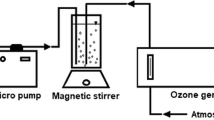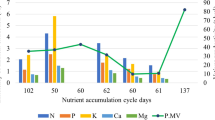Abstract
In this study, an advanced oxidation process using ozone application in a fixed-bed reactor filled with bio-rings was used for purification and disinfection of cattle wastewater (CWW) previously treated in a UASB reactor. The O3 concentration applied to the reactor was 7.8 mg L−1 (±1). Four ozonation times were tested in a batch process: T1 = 0.5 h, T2 = 1 h, T3 = 1.5 h and T4 = 2 h. The pH values tended to increase with the time of contact between liquid and gas. COD and BOD5 removal of 55 and 64% was recorded in T4. Color and turbidity were reduced by 88.5 and 93.4%, while total solids and total suspended solids were reduced by 65.7 and 93.5%, respectively. Oils and greases were completely removed from the wastewater. Electrical conductivity did not vary significantly between treatments, and its association with the presence of cations, such as Na+, Ca2+ and Mg2+, suggests good quality of the water ozonated in T4 for application in the soil, with no risk of salinization. High concentrations of nitrogen compounds were removed, but the efficiency in removing phosphate compounds was low. Coliform removal of above 99% was achieved with T3. Only the CWW ozonated in T4 is recommended for irrigation of raw-consumed crops. Based on most parameters analyzed, the CWW treated in T4 would also be suitable for discharge into water bodies according to Brazilian legislation, suggesting that this technology could be applied in the near future.





Similar content being viewed by others
References
Almeida, E., Assalin, M. R., Rosa, M. A., & Durán, N. (2004). Tratamento de efluentes industriais por processos oxidativos na presença de ozônio. Química Nova, 27(5), 818–824. https://doi.org/10.1590/S0100-40422004000500023.
APHA (2012). American Public Health Association, American Public Health Association, American Water Works Association, Water Environment Federation. Standard Methods for the Examination of Water and Waste Water. 22nd edn. Washington DC.
Araújo, K. S. D., Antonielli, R., Gaydeczka, B., Granato, A. C., & Malpass, G. R. P. (2016). Advanced oxidation processes: A review of fundamentals and applications in the treatment of urban and industrial wastewaters. Revista Ambiente e Água, 11(2), 387–401. https://doi.org/10.4136/ambi-agua.1862.
Ayers, R. S., & Westcot, D. W. (1985). Water quality for agriculture. FAO irrigation and drainage paper 29 (revised 1) (p. 174). Rome: FAO.
Barreto, A. C., & Campos, C. M. M. (2009). Avaliação de um sistema de irrigação autopropelido aplicando água residuária de suinocultura.Ciência e Agrotecnologia, 33, 1752–1757. https://doi.org/10.1590/S1413-70542009000700009.
Bhatta, R., Kayastha, R., Subedi, D. P., & Joshi, R. (2015). Treatment of wastewater by ozone produced in dielectric barrier discharge. Journal of Chemistry, article ID 648162. https://doi.org/10.1155/2015/648162.
BRASIL. Resolução CONAMA 357, de 17 de março de 2005. Conselho Nacional de Meio Ambiente. Available at: http://www2.mma.gov.br/port/conama/legiabre.cfm?codlegi=459. Accessed Dec. 2019.
BRASIL. Resolução CONAMA 430, de 13 de maio de 2011. Conselho Nacional de Meio Ambiente. Available at: http://www2.mma.gov.br/port/conama/legiabre.cfm?codlegi=646. Accessed Dec. 2019.
Cabrera-Díaz, A., Pereda-Reyes, I., Dueñas-Moreno, J., Véliz-Lorenzo, E., Díaz-Marrero, M. A., Menéndez-Gutiérrez, C. L., & Zaiat, M. (2016). Combined treatment of vinasse by an upflow anaerobic filter-reactor and ozonation process. Brazilian Journal of Chemical Engineering, 33(4), 753–762. https://doi.org/10.1590/0104-6632.20160334s20150268.
Clescerl, L. S., Greenberg, A. E., & Eaton, A. D. (2000). Standard methods for the examination of water and wastewater (p. 1220). American Water Works Association: Denver.
de S. Coelho, C. C., Freitas-Silva, O., Campos, R. D. S., Bezerra, V. S., & Cabral, L. M. (2015). Ozonização como tecnologia pós-colheita na conservação de frutas e hortaliças: Uma revisão. Revista Brasileira de Engenharia Agrícola e Ambiental, 19(4), 369–375. https://doi.org/10.1590/1807-1929/agriambi.v19n4p369-375.
Hansson, H., Kaczala, F., Amaro, A., Marques, M., & Hogland, W. (2015). Advanced oxidation treatment of recalcitrant wastewater from a wood-based industry: A comparative study of O3 and O3/UV. Water, Air, & Soil Pollution, 226, 1–12. https://doi.org/10.1007/s11270-015-2468-5.
Júnior, C. B. O., Sandri, D., Alencar, E. R. D., & Hebling, L. F. (2019). Ozonation improves physical attributes in domestic sewage effluent. Revista Ambiente & Água, 14(2). https://doi.org/10.4136/ambi-agua.2328.
Lage, F. F. A. (2008). Avaliação da filtração e ozonização de efluente sanitário primário: aspectos de inativação microbiana e variáveis de ozonização. Química Nova, 31(2), 312–316. https://doi.org/10.1590/S0100-40422008000200023.
Lee, B. H., Song, W. C., Manna, B., & Ha, J. K. (2008). Dissolved ozone flotation (DOF) – A promising technology in municipal wastewater treatment. Desalination, 225, 260–273. https://doi.org/10.1016/j.desal.2007.07.011.
Lei, L., & Li, Y. (2014). Effect of ozonation on recalcitrant chemical oxygen demand (COD), color and biodegradability of hardwood Kraft pulp (KP) bleaching effluent. BioResources, 9(1), 1236–1245.
Mahmoud, A., & Freire, R. S. (2007). Métodos emergentes para aumentar a eficiência do ozônio no tratamento de águas contaminadas. Química Nova, 30(1), 198–205. https://doi.org/10.1590/S0100-40422007000100032.
Marcelino, R. B., Leão, M. M., Lago, R. M., & Amorim, C. C. (2017). Multistage ozone and biological treatment system for real wastewater containing antibiotics. Journal of Environmental Management, 195, 110–116. https://doi.org/10.1016/j.jenvman.2016.04.041.
Mendonça, H. V., Ometto, J. P. H. B., & Otenio, M. H. (2017). Production of energy and biofertilizer from cattle wastewater in farms with intensive cattle breeding. Water, Air, & Soil Pollution, 228(2), 1–14. https://doi.org/10.1007/s11270-017-3264-1.
Mendonça, H. V., Ometto, J. P. H. B., Rocha, W. S. D., Martins, C. E., Otenio, M. H., & Borges, C. A. V. (2016). Crescimento de cana-de-açúcar sob aplicação de biofertilizante da bovinocultura e ureia. Revista Agronegócio e Meio Ambiente, 9(4), 973–987. https://doi.org/10.17765/2176-9168.2016v9n4p973-987.
Mendonça, H. V., Ometto, J. P. H. B., Otenio, M. H., Marques, I. P., & Reis, A. D. (2018). Microalgae-mediated bioremediation and valorization of cattle wastewater previously digested in a hybrid anaerobic reactor using a photobioreactor: Comparison between batch and continuous operation. Sci Total Environ, 633, 1–11. https://doi.org/10.1016/J.SCITOTENV.2018.03.157.
Nakayama, F. S. (1982). Water analysis and treatment techniques to control emitter plugging. Portland, Oregon: Proc. Irrigation Association Conference.
Oller, I., Malato, S., & Sánchez-Pérez, J. (2011). Combination of advanced oxidation processes and biological treatments for wastewater decontamination—A review. Science of the Total Environment, 409(20), 4141–4166. https://doi.org/10.1016/j.scitotenv.2010.08.061.
Paździor, K., Wrębiak, J., Klepacz-Smółka, A., Gmurek, M., Bilińska, L., Kos, L., Sójka-Ledakowicz, J., & Ledakowicz, S. (2017). Influence of ozonation and biodegradation on toxicity of industrial textile wastewater. Journal of Environmental Management, 195, 166–173. https://doi.org/10.1016/j.jenvman.2016.06.055.
Peña, M., Coca, M., González, G., Rioja, R. and García, M. T. (2003). Chemical oxidation of wastewater from molasses fermentation with ozone. Chemosphere, 51, 893-900. 10.1016/S0045-6535(03)00159-0.
Schroeder, J. P., Croot, P. L., Von Dewitz, B., Waller, U., & Hanel, R. (2011). Potential and limitations of ozone for the removal of ammonia, nitrite, and yellow substances in marine recirculating aquaculture systems. Aquacultural Engineering, 45, 35–41 https://doi.org/10.1016/j.aquaeng.2011.06.001.
Silva, A. C., Dezotti, M., & Sant’Anna Jr., G. L. (2004). Treatment and detoxification of a sanitary landfill leachate. Chemosphere, 55(2), 207–214 https://doi.org/10.1016/j.chemosphere.2003.10.013.
Silva, J. B. G., Martinez, M. A., Pires, C. P., Andrade, I. P. S., & Silva, G. T. (2012). Avaliação da condutividade elétrica e pH da solução do solo em uma área fertirrigada com água residuária de bovinocultura de leite. Revista Irriga - Botucatu, special edition, 250–263. https://doi.org/10.15809/irriga.2012v1n01p250
Singer, P. C., & Zilli, W. B. (1975). Ozonation of Ammonia in wastewater. Water Research, 9, 127–134. https://doi.org/10.1016/0043-1354(75)90001-9.
Subha, B, & Muthukumar, M. (2012). Optimization of ozonation process for the reduction of excess sludge production from activated sludge process of sago industry wastewater using central composite design. The Scientific World Journal, Article ID 460 239271. https://doi.org/10.1100/2012/239271.
Vale P., Gibbs H., Vale R., Christie M., Florence E., Munger J., Sabaini, D. (2019). The expansion of intensive beef farming to the Brazilian Amazon. Global Environmental Change Human and Policy Dimensions, 57, article ID: UNSP 101922. https://doi.org/10.1016/j.gloenvcha.2019.05.006.
Wilinski, P. & Jeremi, N. (2012). Dissolved ozone flotation as innovative and prospect method for treatment of micro pollutants and wastewater treatment costs reduction. 12th edition of the worldwide workshop for young environmental scientists (WWW-YES-2012) - urban waters: Resource or risks? France. Available in: https://hal.inria.fr/hal-00709736
World Health Organization (WHO). (2006). Guidelines for the safe use of wastewater, excreta and greywater: Wastewater use in agriculture (Volume II). Available in: http://www.who.int/water_ sanitation_health/wastewater/gsuweg2/en/index.html.
Author information
Authors and Affiliations
Corresponding author
Additional information
Publisher’s Note
Springer Nature remains neutral with regard to jurisdictional claims in published maps and institutional affiliations.
Rights and permissions
About this article
Cite this article
de Souza, D.S., Maciel, A.M., Otenio, M.H. et al. Optimization of Ozone Application in Post-Treatment of Cattle Wastewater from Organic Farms. Water Air Soil Pollut 231, 362 (2020). https://doi.org/10.1007/s11270-020-04736-2
Received:
Accepted:
Published:
DOI: https://doi.org/10.1007/s11270-020-04736-2




